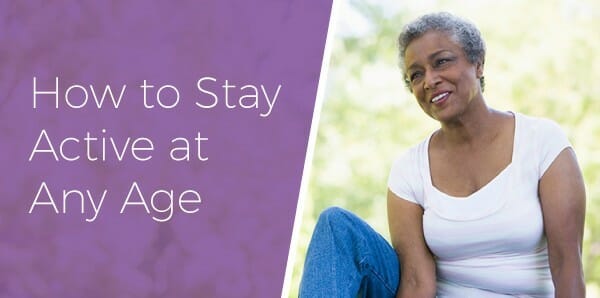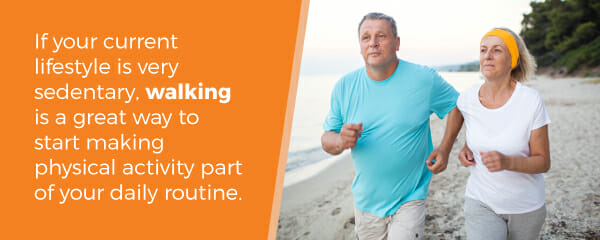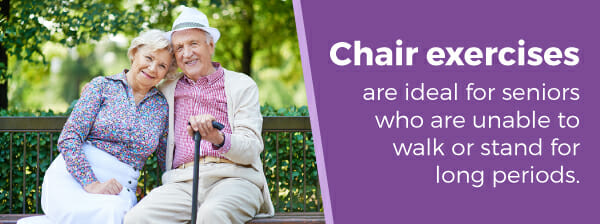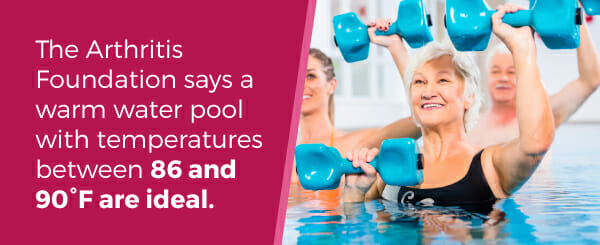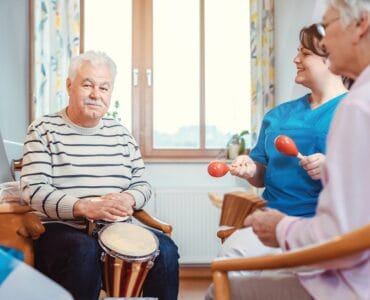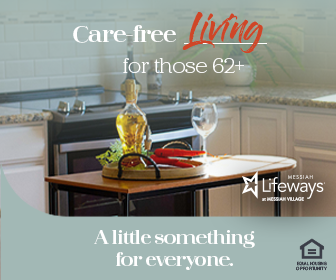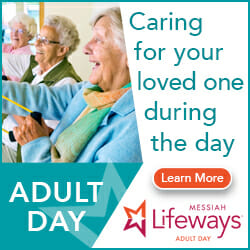Did you know that many of the health problems we associate with aging are actually caused by a lack of physical activity? In fact, making an effort to move more may very well be the “fountain of youth” we crave!
Benefits of Regular Exercise for Seniors
After the kids are grown and we’ve retired, our daily routines slowly become much more sedentary. The body loses strength and stamina because of the decrease in movement. According to the CDC, an astonishing one in three men and one in two women engage in no physical activity at all by age 75. Millions more are thought to engage in only a few minutes of activity per day
Pop culture often focuses on exercise as a weight loss tool, but you should treat regular physical activity as an important part of your overall wellness plan, no matter your body weight. Think of your body as a machine and exercise as a part of your regular maintenance plan to keep all the gears in working order.
Ideally, seniors should engage in at least 30 minutes of cardiovascular activity per day and perform strength training exercise two or three times per week. However, if this is too much for you to handle, it’s fine to begin by exercising in 10 or 15 minute intervals. Anything you do to increase your daily physical activity is better than nothing. Fitness is a personal journey, not a competition!
For seniors, regular exercise offers benefits such as:
- Preventing loss of muscle mass: The National Center for Biotechnology Information reports that muscle mass naturally starts to decrease as we get older. The average adult loses 3% to 8% of muscle mass per decade after age 30. When muscle mass is reduced, this affects your balance and overall mobility. As a result, you’re more likely to fall or have trouble performing the daily activities associated with independent living. Luckily, regular exercise can slow down this process.
- Increasing flexibility: Activities that involve stretching different parts of the body increase overall range of motion. This makes it easier for a senior to continue enjoying the activities of daily living without pain or discomfort.
- Releasing endorphins: The release of endorphins from exercise improves your mood and wellbeing, especially if you’re struggling with anxiety or depression.
- Improving mental function: Exercise increases the amount of oxygen in the brain, which leads to greater mental clarity. This leads to fewer of those embarrassing “senior moments” we associate with the aging process.
- Reducing the risk of serious health problems: When you exercise regularly, you’re less likely to develop colon cancer, breast cancer, diabetes, cardiovascular disease and high blood pressure. If you have a genetic predisposition to any of these conditions, increasing your physical activity is a smart preventative measure.
Starting an Exercise Program
Almost all adults can safely engage in a regular exercise program. However, it’s always a good idea to talk to your doctor before you begin any new physical activity. They can review your medical history and address any concerns.
Some general safety tips to remember when you’re exercising include:
- If you have a cold, flu or other illness, you should not exercise until you’re feeling better.
- Your workout shouldn’t cause more than mild discomfort. If you are in pain after you finish exercising, you may have pushed your body too far.
- Symptoms such as pain or pressure in your chest, difficulty breathing, dizziness, trouble keeping your balance or nausea while exercising indicate you need to visit your doctor.
- Don’t hold your breath while exercising. Focus on breathing at a steady, even pace.
- Always stretch before and after exercising to prevent injury. When stretching, aim to move in a slow, controlled fashion. When your movements are erratic, you increase your risk of injury.
- Exercise with a partner. Having a friend to visit with while you’re exercising will make the activity more enjoyable, but a partner also helps keep you safe by being around to seek help if you become dizzy or injure yourself.
- It’s better to exercise in the morning or evening when it’s not as hot outside. This will help you stay cool and avoid problems associated with overheating.
- Remember to drink plenty of water or sports drink before and after you exercise. If you feel thirsty, your body is telling you that you’re dehydrated.
Walking for Seniors
If you’d describe your current lifestyle as very sedentary, walking regularly is a great way to start making physical activity part of your daily routine. Many already consider walking, gardening or yard work popular choices for physical activity among adults ages 65 and over.
The benefits of walking include spending more time outdoors, improving your mood, helping you maintain a healthy body weight, improving balance and coordination and strengthening your bones and muscles. In fact, walking is one of the simplest ways to enjoy an active lifestyle no matter what your age!
All you need to begin your walking routine is a comfortable and supportive pair of shoes, although it’s smart to carry a cell phone with you to call for assistance if needed. If possible, you’ll want to walk with a friend for added socialization and safety benefits.
Seniors who are unable to walk without the use of a cane or walker shouldn’t feel like they need to stay at home. Walking with these aids for as long as you are able to manage still provides significant health benefits. If walking becomes a regular part of your routine, you might even find that you’re no longer dependent upon these aids.
The CDC classifies walking for fitness as a moderate intensity activity. This means you should be able to comfortably talk while walking, but not be able to sing a song. If you’re struggling to say more than a few words before taking a breath, you should slow down your pace. Difficulty speaking is a sign you’re overexerting yourself.
If you enjoy spending time outdoors, most communities have several trails designed for biking, jogging and walking. If you’d prefer to walk indoors, malls, schools and recreation centers often have special hours for seniors to take a stroll. Another alternative is to start by simply walking around the block a few times. Alternatively, park a little further from the store when you’re running errands. These short distances add up quickly!
Biking for Seniors
Do you have fond childhood memories of exploring your neighborhood on your bike? Many seniors give up biking as they age for fear of falling, but recumbent bikes let you experience the joy of biking while staying safe.
Recumbent bikes offer superior back support when compared to an upright bicycle. The stretched angle of the user’s legs also makes this type of bike easier to operate if you have knee problems or arthritis pain. If you’re worried about keeping your balance, three-wheeled recumbent trikes are other options to consider. In fact, the AARP reports that adults age 50 or over make up 75% of the leading recumbent trike manufacturers’ customers.
In a gym, a recumbent stationary bike lets you exercise while reading a book or watching television. Some bikes also have advanced features, like a built-in heart rate monitor or speed and resistance adjustments that let you easily customize your workout to fit your own unique needs.
Chair Exercises for Seniors
Chair exercises are ideal for seniors who are unable to walk or stand for long periods. Chair exercises can be performed in a group setting. However, you can also choose to work out in the comfort of your own home while watching your favorite television show.
Stretching and strength training are the two primary goals of any chair exercise routine, although some routines also include standing exercises that use the chair back to make it easier for you to keep your balance.
One popular stretch is the overhead reach with side bends. To perform this exercise, sit in a chair and reach your arms up overhead. Hold them still for 10 seconds, and then let your right arm slowly move to your side while extending your left. Bend your body slightly to the right and hold for 10 seconds, then come back up to the center position. Repeat this exercise with the left side.
For strength training purposes, routines may use light hand weights or weighted balls. These weight lifting exercises help work the triceps and biceps.
Aquatic Training for Seniors
Exercises that take place in a pool are easier on your joints and bones than those on the ground. Postmenopausal women who suffer from osteoporosis or are concerned about low bone density often find that they prefer exercising in the water because they’re no longer afraid of falling. If you suffer from arthritis or orthopedic problems, the Arthritis Foundation says a warm water pool with temperatures between 86 and 90°F are ideal.
Swimming may be the most popular way to work out in the water, but it’s not the only option. Aqua walking or aqua jogging are common forms of aquatic training for seniors. Water aerobics classes are another option to consider as well, since they use kickboards, water weights, hand webs and pool noodles to create resistance and help strengthen the muscles.
Yoga for Seniors
Yoga is another exercise often recommended for seniors. Contrary to popular belief, you don’t need to be exceptionally thin, flexible or young to enjoy yoga. Everyone, regardless of their fitness level, can participate in this activity.
Some of the many benefits of yoga include:
- Reduce risk of falling: Yoga poses help you develop a better sense of balance, which reduces the risk of falls that can cause serious injuries in older adults.
- Control hypertension: Hypertension is a common health problem among older adults, but yoga can help by offering a good way to reduce stress. Older adults who practice yoga regularly often find they need less medication to control their hypertension.
- Strengthen your bones: For postmenopausal women, low bone density is a serious issue. Weight bearing yoga poses can help slow the bone thinning that occurs with age.
- Safeguard your joints: A regular yoga practice helps lubricate your body’s joints. This is useful because it minimizes the issues associated with arthritis and other joint disorders.
The key to practicing yoga as a senior is to modify poses to fit your ability level. For example, the plank pose traditionally looks like the “up” portion of a push-up. However, if you can’t hold your body in this position, you can try putting your knees on the ground. Even with the modification, the pose will still help you build body strength and enhance your core stability. Other yoga poses can be modified by using a block, strap, bolster or chair.
Activities for Mental Health
If you have health concerns that limit your mobility and you aren’t able to exercise as much as you’d like, there are still many ways to keep your mind sharp as you age. Some easy activities many seniors enjoy include:
- Adult coloring books: Coloring isn’t just for children anymore. Coloring books for adults have exploded in popularity in recent years, with designs available featuring everything from animals to characters from popular TV shows. Coloring helps relieve stress, provides an outlet for self-expression, improves dexterity and helps maintain motor function. Coloring can also be a wonderful social activity, whether you color with a group of friends or spend some time bonding with your grandchildren over a new book.
- Solving puzzles: Crossword puzzles, word searches, Sudoku puzzles and other similar activities provide a mental challenge and feelings of accomplishment. For seniors with vision difficulties, large print puzzle books are available.
- Weekly game nights: If you have a favorite board game or card game, getting together on a regular basis to play with friends provides socialization as well as mental stimulation. For times when traveling is difficult, there are a number of online websites that let players enjoy computerized versions of their favorite games.
- Gardening: Gardening is an activity that many seniors undertook out of necessity when they had hungry children at home to feed. However, gardening can bring personal satisfaction during any stage of life. Growing a garden encourages you to spend time outdoors and to increase your physical activity as your health permits. If it’s been a few years since you maintained a garden regularly, a small herb or flower garden is a manageable place to take up this hobby once more.
- Woodworking: Senior men often find working with their hands to construct simple projects to be relaxing. Cutting boards, bookends, candleholders, trays and other small items are easy to construct and make lovely gifts for family and friends.
Embracing Every Day with Messiah Lifeways
Headquartered in Mechanicsburg, PA, Messiah Lifeways is a non-profit organization serving adults ages 55 and over. Our goal is to inspire older adults to embrace the changes that aging brings by staying physically, mentally and spiritually active. To learn more, please call us at 717.697.4666 or email life@messiahlifeways.org.

